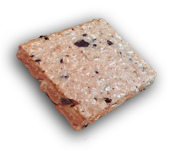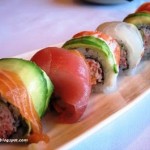If you enjoy sushi, you typically imagine it’s super-healthy. Ignorance can be bliss…unless you’re trying to downsize the waistline, tone-up, lower cholesterol…etc.
To ensure you eat the freshest fish and the most nutritive meal:
1. Choose sashimi over nigiri or rolls to avoid large amounts of rice. Large fleshy lean fish such as tuna, salmon & yellowtail is healthier than eel, shrimp and all shellfish including lobster, surfclam and real or fake crab. The latter is actually fish, a very processed Pollack. You may borrow this moniker: the “hotdog of sushi.”
2. Can’t quit the maki? Look for rolls with fish on top/outside. They contain the most fish and are priced higher for the obviously higher return on investment. While many establishments have rolls unique to their menu, the Rainbow Roll (pictured above) is a standard. It has salmon, tuna, yellowtail and possibly other fish on top of a California roll. Ask for real crab inside and hold the mayo, or better yet, substitute a meatier fish like salmon or tuna or a vegetable like spinach or cucumber. You may be upcharged for more expensive fish, but it’ll be more nutritive than hotdog crab and mayonnaise.
Biggest threats to otherwise healthy sushi, and how to get around them:
1. White rice – unless the menu says otherwise, expect white rice under each mound of nigiri, surrounding your maki rolls and under your chirashi or don. Sadly, the white rice has no food value, it is simply filling. The type of filler that in large quantities inflates the abdominal tire and raises blood sugar, which we all know will make you consume more calories in the end. Ask if brown rice or a cucumber wrap in place of the white rice. Substitute a salad or bed of fresh veggies for the rice in a bowl of Chirashi and you made the healthiest meal in the restaurant. Note: a sushi chef’s skill is measured by how thin he can make the circle of rice on the outside of maki rolls. The most dexterous chefs can expertly roll minimal rice or cucumber, which are harder to roll than mountains of sticky white rice. The response from both a server and/or the chef himself to: “can I have that wrapped w/ brown rice or cucumber instead of white” is a huge indicator of the entire restaurant. Encounter rigidity, scowling, or complete non-compliance? Walk.
2. Mayonaise – In the same way a deli sneaks it into a sandwich piled high with lean meats and healthy veggies, mayo makes a surprise appearance in many of rolls created. You’ll find it in anything that looks like it has the texture of tuna salad, as it is added to shredded fish to create a spreadable paste and holds the roll together. Mayo also lurks in items labelled “spicy,” as the sauce is typically mayonnaise mixed with sriracha sauce. The full-fat mayo contributes heavily to the fat content of otherwise healthy sushi. Additionally, expect old fish in spicy sushi, as chefs typically collect the less desireable shreds of fish through the day to make tomorrow’s spicy sushi. Any unpleasant taste indicates past-peak fish is covered in the powerful peppers that make sriracha dangerously delicious. Avoid, by asking the chef for “no mayo, please.” If you’re worry he will replace it with more sriracha in your spicy pieces, request that the spicy be made mild. (Specifically using the word “sriracha” indicates you know your sushi-whether you do or don’t).
3. Sauces – while spicy, honey mustard and any opaque sauces are typically full-fat mayonnaise-based (see above), sweet miso, ponzu and other more transparent sauces usually are loaded with sugar or high fructose corn syrup. Just like that salad dressing, ask for it on the side and dip lightly, dear. Regarding soy sauce – always ask for low sodium soy sauce.
4. Tempura – Even if it’s a vegetable, it’s still fried, and honestly, not lightly. Tempura items contribute substantial fat, mostly saturateed, and calories. “Tempura,” “flakes” or “crunch” all translate to tempura. If you see it, politely ask for “no tempura” in your sushi.
Always remember, you’re enjoying a cuisine from a very formal culture, and a cuisine that is considered art. You will find places with rigid chefs, who refuse to make healthy substitutions, as they see it as an insult to the culture or their body of work. Always smile and ask politely, be respectful and praise the food. As a last resort, develop a sudden “food allergy” to whatever you’re trying to avoid. If you’re still feeling like “persona non grata” after your most polite efforts to negotiation, find the nearest exit. You have no reason to give your biz to a restaurant who won’t work with you.








 Loved ushering the GOLDEN ERA for
Loved ushering the GOLDEN ERA for 





